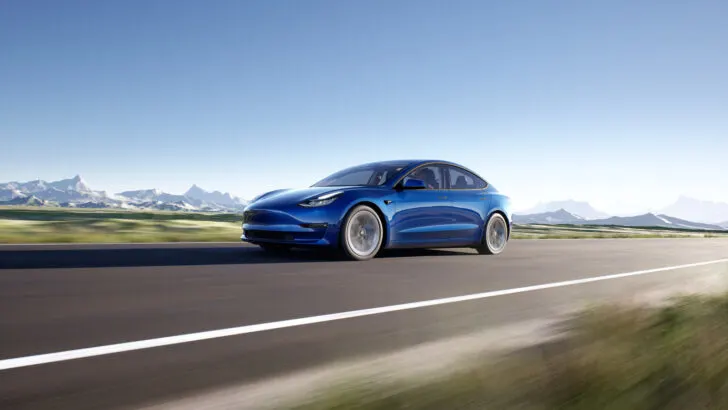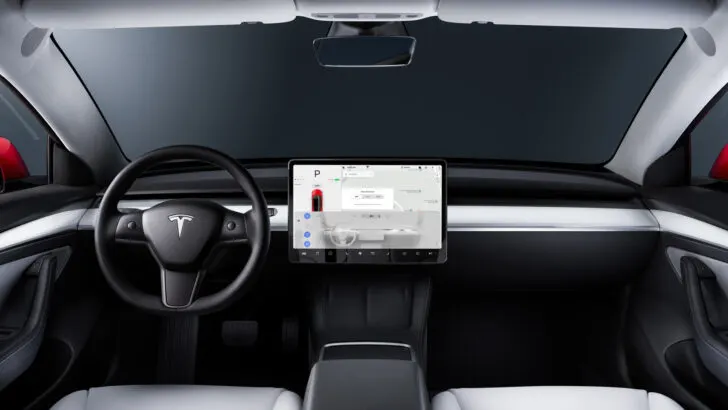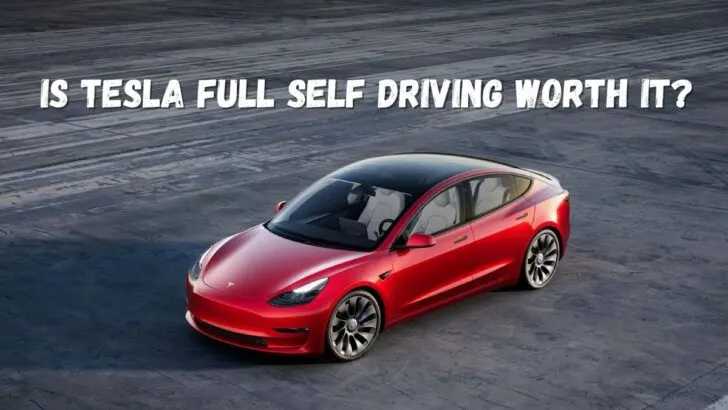Tesla is renowned for its innovative and computer-driven technology geared towards developing fully autonomous, or self-driven, vehicles.
Going to your destination while taking a nap in your car may seem thrilling to some as we embrace advances in automobile technology.
However, the hefty price tags on these systems have left many drivers wondering whether they’re worth their money.
An example is the Tesla Full Self-Driving (FSD) package, whose price has risen to $15,000. For a car, this is quite costly, considering that the package is still in development.
So, what is the FSD? Why the high price tag? Is it worth it? Read on to find out.
Is Tesla Full Self-Driving Worth It?
Deciding whether the FSD is worth the price is subjective, and you should decide after weighing the pros and cons. However, if you’re wondering if it’s worth it right now, the answer is no.
The FSD is a computer-driven advanced driver assist feature that’s nowhere near full autonomy.
According to Tesla, it does not make your car autonomous, and it is your responsibility as a driver to stay alert and keep your hands on the steering wheel at all times.
Additionally, company CEO Elon Musk asserted that the price of the FSD package would keep rising as they get closer to achieving full self-driving.
Initially, the FSD cost $8,000, with the price growing to $10,000 in 2021, $12,000 at the start of 2022, and $15,000 in September 2022.
And we expect the price to keep rising as Tesla adds more features and upgrades the existing ones.
However, it’s worth noting that the FSD is a Level 2 autonomy package with the potential to achieve Level 5 abilities.
In other words, you’re banking on potential by buying the package at $15,000 since you expect the price to go higher.
If you’re on a tight budget or wouldn’t like to buy based on a potential rise in value, we’d recommend going with the Enhanced Autopilot package.
The $6,000 package has all the features of the current FSD version minus the Traffic and Stop Sign Control feature, which is in beta and not very useful yet.
Conversely, the FSD promises more features and is a step closer to Level 5 autonomy. It’s only a matter of time before Tesla introduces more features that should make the $15,000 buying price a big bargain.
However, we don’t know when Tesla will roll out the complete package, and for now, just save the $9,000 and go with the Enhanced Autopilot.

What’s Tesla Full Self-Driving?
Tesla Full Self-Driving is an upgrade to the Autopilot suite of advanced driver-assistance systems (ADAS). It allows Tesla vehicles to drive autonomously to a predetermined location on its navigation system.
Whereas Autopilot does instrument-directed maneuvers and highway navigation at interstate speeds, the FSD provides additional ability to navigate city streets and residential areas.
In other words, Tesla has three ADAS levels geared towards full autonomy, the most advanced being the FSD.
These are Autopilot, Enhanced Autopilot, and Full Self-Driving technology. As of 2022, the company limits the number of people with access to the FSD technology for safety reasons, as the package is still in development and available to over 100,000 people.
Autopilot, Enhanced Autopilot, and Full Self-Driving Capability
Tesla has come a long way in its quest to have fully autonomous vehicles on our roads.
In 2013, CEO Elon Musk first introduced us to Autopilot, noting that the system works well in planes and should be extended to our cars.
Over the decade, Tesla has designed and redesigned its cars to be efficient and comply with regulations in various regions.
Additionally, Tesla aims to achieve full self-driving by training their vehicles’ neural networks using the driving habits of more than 100,000 drivers.
The company deliberately decided to use visible light cameras and other vital car components, such as the ultrasonic sensors used for parking, in place of the more popular LiDAR system.
And according to Musk, all modern Tesla cars have FSD hardware, and its use is a matter of software limitation.
But how do the Autopilot, Enhanced Autopilot, and FSD features compare?
Autopilot
The Autopilot is the lowest tier and has limited functionality and features, including:
Traffic-Aware Cruise Control: Matches your car’s speed to that of close traffic.
Autosteer: Uses Traffic-Aware Cruise Control to aid in steering your car on roads with clearly marked lanes.
Enhanced Autopilot
The Enhanced Autopilot has five features in addition to what the Autopilot offers. These are:
Navigate on Autopilot: Guides your Tesla actively from a highway’s on-ramp to off-ramp. This includes suggesting changing lanes, navigating interchanges, turning on the turn signals, and correctly taking the intended exit.
Auto Lane Change: Works with Autosteer to move your car to an adjacent lane while on the highway.
Autopark: Automatically parks your car in perpendicular or parallel parking.
Summon: Enables you to move your car automatically from or into tight spaces using a Tesla key or mobile app.
Smart Summon: An advanced feature that allows your car to navigate tight and complex spaces to find you in a parking lot.

Full Self-Driving Capability
The FSD is the most advanced of the three and is a step closer to achieving fully autonomous driving in your Tesla. In addition to the features and functionality of the Autopilot and Enhanced Autopilot, the FSD capability includes:
Traffic and Stop Sign Control (Beta): Identifies traffic lights and stop signs and automatically decelerates your vehicle as you approach a stop.
It also has a driving visualization display showing upcoming stop signs, traffic lights, and other crucial road markings.
Autosteer on City Streets: This option is coming soon!
How Do I Access the Tesla FSD?
To access the FSD, you must meet a specific safety score criteria Tesla sets.
The Safety Score Beta is an individual assessment of your driving behavior to determine if you can use the FSD without endangering other road users.
It is a score ranging from 0 to 100, where a higher score indicates that you’re a safer driver.
According to Tesla, here are the five factors that affect your Safety Score.
Hard Braking: This is a backward acceleration of your car in excess of 0.3g or a deceleration larger than 6.7 mph in one second.
Aggressive Turning: This is left or right acceleration in excess of 0.4g or an acceleration larger than 8.9 mph in one second while turning.
Unsafe Following: This is a measure of the number of seconds it takes you to react and stop if the lead vehicle comes to a sudden stop (headway). In other words, it is the proportion of time when your Tesla’s headway is less than 1.0 second compared to when it is less than 3.0 seconds.
Forward Collision Warnings per 1,000 miles: It’s the number of visual and audible alerts in events when a collision is likely to happen without your intervention.
Forced Autopilot Disengagement: A Tesla disengages the Autopilot system after you, the driver, receive three audio and visual warnings for inattentiveness.
What Safety Score do I Need for Tesla FSD?
Safety Score Beta requirements may change from day to day or over time and vary depending on your region. Currently, you need a 95 to 100 Safety Score rating monitored over seven days to access the Tesla FSD.
Since some drivers don’t pay much attention to their driving style, only a few are able to achieve this high score.
On the positive side, you can improve your score by avoiding unnecessary aggressive turning, hard braking, unsafe following, forced Autopilot disengagement, and sharp acceleration that may result in sudden braking or Forward Collision Warnings.
The Takeaway to Tesla’s Full Self Driving
In the past, Tesla had Autopilot and the FSD options in all of their cars. Therefore, many people would pay to get the latter as it was a massive upgrade compared to Autopilot.
However, the possibly low demand for the FSD meant that most Tesla owners didn’t get the needed taste of what the package offered.
This forced Tesla to re-introduce the $6,000 Enhanced Autopilot as a step toward Full Self-Driving capability. Currently, the package shares most of its features with the FSD and is a good bargain for drivers.
On the brighter side, the introduction of Autosteer on City Streets may push the FSD’s popularity to heights never seen before.
The feature allows your car to navigate around complex city environments without driver input.
The only challenge is that we don’t know when Tesla will roll out this feature.
We shouldn’t bet on promises, especially with the company’s history of missing deadlines.
Sources
https://www.tesla.com/support/autopilot#:~
https://www.tesla.com/support/full-self-driving-computer
https://www.tesla.com/support/full-self-driving-subscriptions
https://www.notateslaapp.com/fsd-beta/
https://www.notateslaapp.com/news/594/how-to-increase-your-tesla-safety-score
https://edition.cnn.com/2022/09/07/business/tesla-fsd-price-increase/index.html
